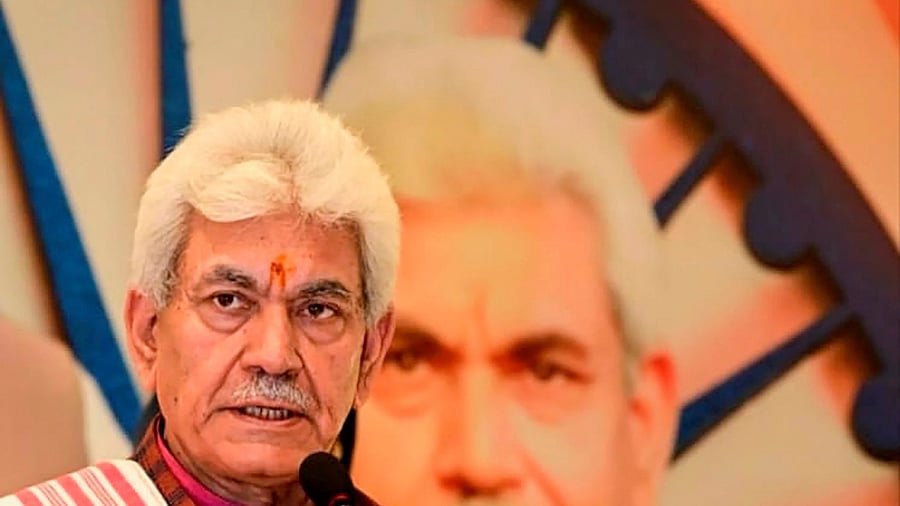
Jammu: Jammu and Kashmir Lt Governor Manoj Sinha addresses a seminar on ‘Financing the Future of Agriculture’, in Jammu
Credit: PTI photo
Srinagar: On August 6, Manoj Sinha will complete five years as the Lieutenant Governor of Jammu & Kashmir, capping a turbulent term that ranged from bureaucratic overhaul to resurgence of violence.
Appointed in the aftermath of Article 370’s abrogation, Sinha, an MTech holder in engineering, was tasked with stabilising and integrating a politically fractured region. His term delivered visible developmental results, but also deepened political alienation.
A seasoned politician and former Union minister, 66-year-old Sinha brought order to a chaotic administrative landscape. But as his fifth year as J&K’s L-G nears an end, the question lingers: Did he bring peace or just paused the conflict?
Known for his calm and technocratic style, Sinha’s record in governance and delivery in the Union Territory drew praise even from his critics. His notable moves included ending the ‘Darbar Move’ — a bi-annual shift of the Secretariat from Srinagar to Jammu and vice-versa — digitising land and revenue records and streamlining administration through e-governance.
Besides, the L-G promoted foreign and domestic investment, with the launch of an industrial policy, and positioned the region as a year-round tourist destination. J&K clocked a record two crore visitors in 2023 and Srinagar hosted the G20 tourism working group meet, boosting Delhi’s global narrative of “normalcy”.
His public grievance platform ‘L-G’s Mulaqat’ became a model for real-time redressal. Sinha also empowered panchayats and district development councils, introduced youth development programmes and expanded sports and skill centres — all with the declared aim of weaning youth away from militancy.
But beneath impressive statistics and a veneer of normalcy, J&K’s security landscape began to unravel. The April 22, 2025, terror attack in Pahalgam, which claimed the lives of 25 tourists and a local resident, marked a grim return of high-profile violence to the Valley. It preceded a series of deadly ambushes on security forces and civilians in Rajouri, Poonch, Reasi and Doda districts since 2021.
The deadly Pahalgam attack triggered a political uproar. Chief Minister Omar Abdullah squarely blamed Sinha, saying: “If anyone must take responsibility for the Pahalgam lapse, it is the L-G, who controls every lever of power in J&K.”
Indeed, in a rare admission, Sinha accepted “personal responsibility”, calling it a “security failure” — but cautioned against interpreting the attack as proof of widespread terrorist resurgence across the Union Territory.
Still, the incident, and others preceding it, punctured the narrative of stability and laid bare the limitations of a top-down, heavily militarised security model — where enforced calm was often mistaken for durable peace.
The most persistent criticism about Sinha is his poor rapport with mainstream Kashmir-based political parties. Leaders from the ruling National Conference (NC) and opposition People’s Democratic Party (PDP) accuse him of bypassing elected voices, marginalising dissent and reducing democracy to a token.
This vacuum allowed distrust to fester. Many Kashmiris came to view the L-G’s office as an extension of Delhi’s will — not a representative of the people.
“The L-G is not just running the administration; he’s systematically undermining democratic institutions,” said National Conference MLA Tanvir Sadiq.
“He’s interfering in the functioning of the Information Department, deliberately delaying the finalisation of ‘Business Rules’ for the elected government, and even stalling the appointment of the Advocate General. This is not governance—it’s control,” the ruling party lawmaker alleged.
Political observers agree Sinha could have balanced his bureaucratic efficiency with political outreach. “Instead of governing through files and agencies alone, he could have initiated structured dialogue with civil society, youth and traditional parties—even those critical of Delhi,” a professor of Political Science department at University of Kashmir told DH.
Sinha’s refusal to address the question of restoring J&K’s statehood — despite repeatedly promising “at an appropriate time” — has left a critical issue unresolved, making even positive reforms seem imposed rather than earned, he added.
As August 6 nears, Delhi remains tight-lipped on whether Sinha will be retained. Some officials see him as a stabilising figure who managed a volatile phase with minimal disruption. Some others, especially within the BJP, reportedly advocate for a softer replacement — a politician with deeper public connect.
The decision could signal whether Delhi sees J&K as a law-and-order problem or a political project needing reconciliation.